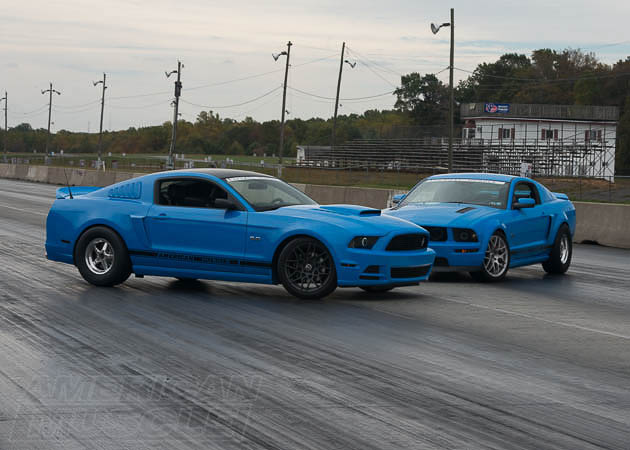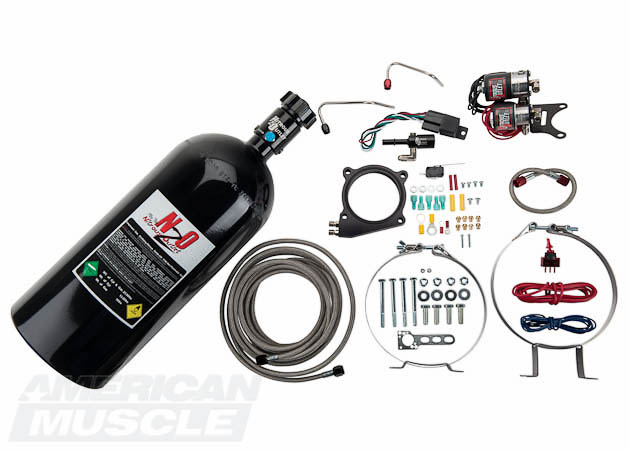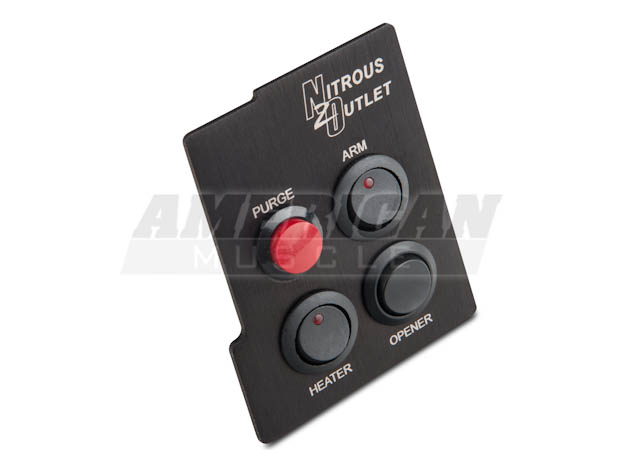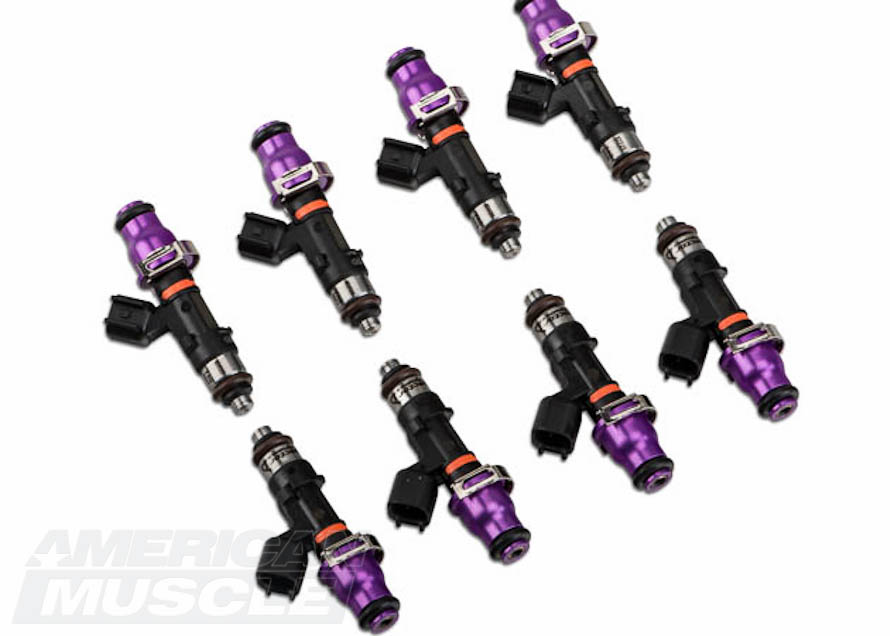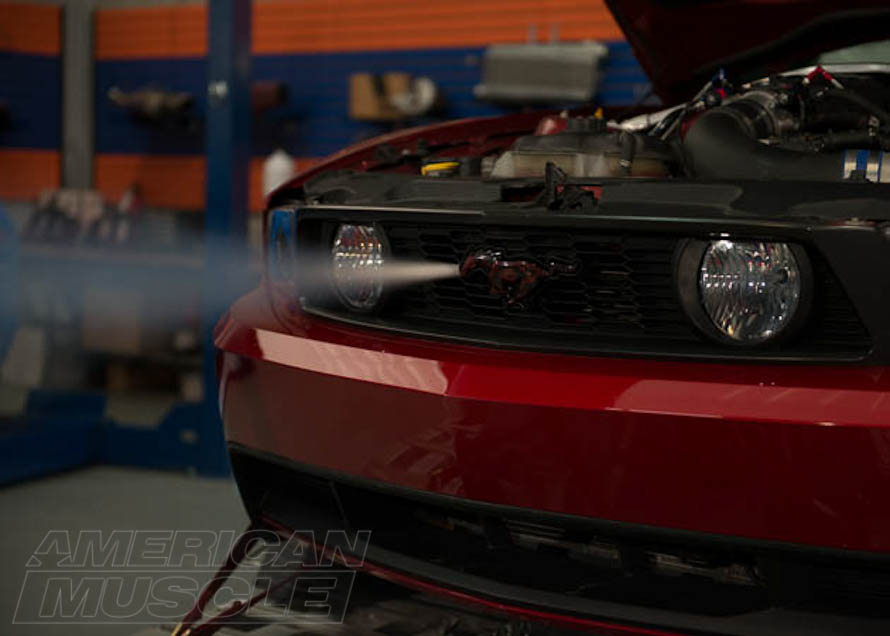The two nitrous kits on the market are wet and dry kits. In the quest for power, it's important to understand the difference between both setups of this “magic juice." Nitrous oxide is a compound chemically represented by two parts nitrogen and one part oxygen. It’s an anesthetic also known as, laughing gas. Obviously, we’ll be focusing on its other use, making power in an internal combustion engines.
Shop Mustang Nitrous
Nitrous will give your Mustang the spark it needs to blow the doors off the competition. With no other modification is it as easy to hook up tens of hundreds of horsepower will little more than a simple kit.
Shop Nitrous
Nitrous Oxide History
The use of nitrous oxide in combustion engines dates back to WWII. The German Air Force experimented with the use of nitrous in their planes, in an attempt to gain an advantage over the Allied forces. The Germans were hoping to use nitrous to increase their combat planes performance at higher altitudes, but overall its use ended up being limited to reconnaissance and bomber aircraft. Later, the British tried to use nitrous in some of their fighter planes as well.
In later years, nitrous found itself in drag racing as well as during the 50s and 60s muscle car era. Racers were always looking for an advantage, and nitrous was a cheap power option which could be hidden fairly easy. This made it ideal, if one wanted to keep a potential advantage secret. In turn, this led to the association of nitrous being “cheating”, which still haunts its use in the minds of many.
How Nitrous Oxide Works with Your Mustang
Nitrous oxide is a gas containing nitrogen and oxygen. When heated above 570 degrees Fahrenheit, the nitrogen and oxygen break apart, releasing more oxygen into the combustion chamber. More oxygen means more fuel can be added to the mix which of course equals more power. Nitrous also has a cooling effect on the intake charge. The cooler intake air is thus denser, so more of it can be packed into the combustion chamber also resulting in more power.
What are the Advantages to Nitrous over Other Power Adders?
Nitrous has a couple of distinct advantages when compared to other power adders. First and foremost are the upfront costs associated with purchasing and installing a system. Superchargers start around $3,500 and go up from there. A nitrous kit generally starts around $500, and even with several accessories is still just a fraction of the cost of a supercharger.
The second advantage is, unlike a supercharger or turbo, nitrous cools the intake air. A supercharger or turbocharger compresses the incoming air, and when air is compressed it heats up. The hotter air reduces the availability of power from a cooler charge and raises operating temperatures. This is one reason why higher supercharging and turbo applications gravitate towards the use of an intercooler.
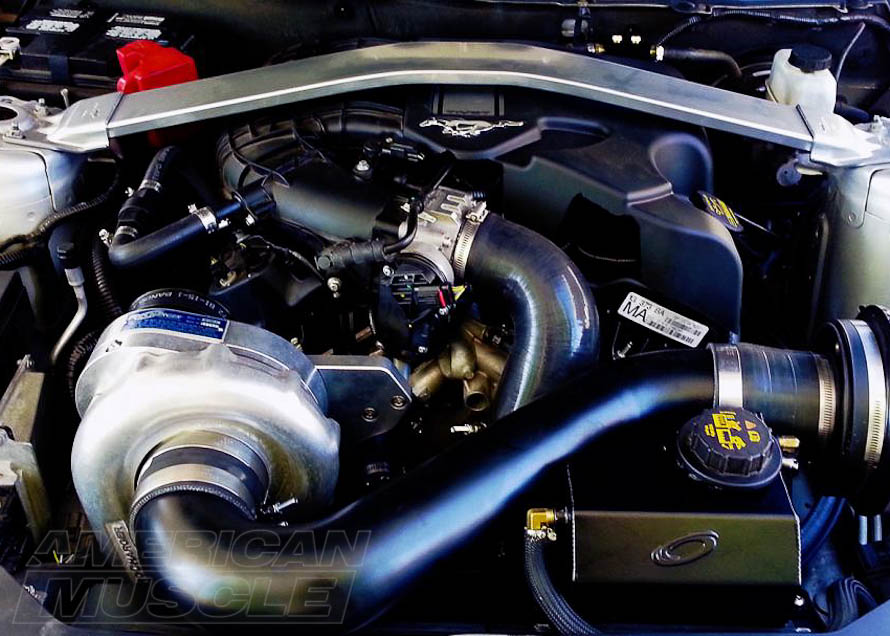
Centrigual Supercharge on a 2011-2014 V6
Nitrous has one chief disadvantage when compared to other power adders though. You need to keep refilling the bottle. How long a bottle lasts will vary depending upon how much nitrous you’ll use. The average price varies from location to location, so you’ll generally find prices of around $30-50 for a bottle refill. You’ll want to plan ahead when looking for a nitrous system, and have a location picked out for getting your bottle filled. Keep in mind, you’ll need to get the bottle filled before installing as nitrous bottles are shipped empty.
Another disadvantage is legality. In many places, nitrous is reserved for track use only and is illegal on the street (like off-road x-pipes...). It is NOT illegal to have the equipment in the car, but it cannot be hooked up while driving your Mustang on public roads. If an officer notices your kit is hooked up, depending on your region, this can be a ticketable offence (and sometimes the car can be sent for inspection).
How Does a Nitrous System Operate?
A basic nitrous system operates as follows. The bottle valve is opened. Then the driver activates the system by arming the main power switch. Then when either the car is at wide open throttle or reaches a specified RPM with a window switch, the solenoids or management unit are activated. This allows the nitrous to flow into the engine via the injector plates or nozzles. When the liquid nitrous is exposed to the atmosphere, it changes from a liquid to a gas.
The change from a liquid to a gas causes a large drop in the intake temperature of the engine. The result is a much denser charge of air, allowing the engine to burn more fuel. Remember an engine is nothing more than a big air pump, and the way to achieve more power is to simply stuff more air and fuel into it. This is the basic concept of any power-adder such as nitrous oxide, supercharging, or even turbocharging. It’s important to add the proper amount of fuel to the motor, as without it, the engine would run dangerously lean. How the extra fuel is added will vary with the type of nitrous system used.
What Parts are Needed for a Mustang Nitrous Setup?
In general a nitrous oxide system for a Mustang consists of a pressurized bottle of nitrous, purge system, lines to plumb the nitrous to the engine, a switch for activation, and various plumbing fittings depending on the system. Of course there are other parts depending on the exact kit and application.
With a switch located near the driver, a “shot” of nitrous is delivered to the fuel system. A shot is slang for the amount of nitrous delivered per use, usually in a predetermined horsepower rating (examples would be a 50, 100, or 150 shot. Equal in number to the amount of horsepower each provides). The switch triggers a solenoid (electrically controlled valve) to open, delivering the nitrous.
How Safe is Nitrous on My Mustang's Internals?
The size of nitrous can vary based on the engine inside the car. For example, a 4.6 2v can handle about a 125 shot in stock conditions. At the same time, a coyote engine can handle a 150 shot depending on the tune. There are certain things that compliment the actual nitrous setup. This includes but isn't limited to a purging system (kits are plentiful), bottle heater, window/WOT switch, dyno tune, etc.). Internal wise, things such as connecting rods, pistons, crankshafts, are all things to be considered when rebuilding an engine for nitrous. Generally, when nitrous causes an engine failure, it's not something that can be fixed short of a rebuild.
The Nitrous Bottle
Nitrous oxide is stored as a liquid in a cylinder that’s referred to as a bottle. The most common size bottle is a 10 lb. bottle, although there are several sizes. The bottle is normally mounted at the rear of the vehicle with the valve handle pointing to the front of the vehicle. The top of the bottle is generally higher than the bottom of the bottle. This positioning is important since nitrous is stored as a liquid. The goal is to have the pickup tube inside the bottle, fully immersed, so there’s no interruption in nitrous delivery. As the vehicle launches, the front of it lifts. With the top-high/bottom-low set up, the pickup tube will remain immersed in the liquid nitrous.
In some situations it may be necessary, or desired, for the bottle to be oriented differently. In these cases the pickup tubes positioning should be considered and altered if needed. In some circumstances the pickup may even be removed, and the bottle mounted upside down.
The Feed Line
The nitrous feed line carries the nitrous from the bottle to the front of the car, stopping at the solenoids. This line will be routed under the car, and it’s important it’s kept away from areas that may cause damage. You’ll also have a vent tube that connects to the bottle which will be routed out of the car. Usually, this goes through the trunk bottom in the same manner as the feed line does. The vent tube allows the nitrous to exit the cabin of the car should the bottle’s safety valve fail. An entire bottle of nitrous venting inside the car would be a very dangerous situation.
Nitrous Solenoids
The solenoids control the flow of the nitrous, as well as the extra fuel needed, if a wet nitrous system is used. In the past nitrous solenoids were essentially the same, and easily recognized under the hood. In more recent times, they have become more complicated. Sometimes the traditional solenoid is shunned in favor of a management unit that regulates the flow of nitrous and fuel if needed. Regardless, the purpose is still the same. Send the nitrous towards the engine when called upon to do so.
Jets
Jets are small items resembling nozzles on a garden hose sprayer, although on a much smaller scale. The jets allow you to control the rate of nitrous and fuel into the engine for wet nitrous kits. The jets are often categorized by the amount of horsepower they’ll add. So adding horsepower is as simple as swapping the jet used in the system.
Switches
The switch is used to activate the system and start the flow of nitrous. In reality there is often more than one switch used, forcing several criteria to be met before the nitrous flows. When discussing the basics, however, they’re all part of the same genre of component. Possible switches are: the wide open throttle switch, window switches, and a boost switch. Several of these are often used together.
Wide Open Throttle Switch: This switch can vary, from a mounted switch to an electronic device wired into a computer system on drive-by-wire cars. Regardless, the result is the same, even when the nitrous system is armed, nitrous will only flow if the engine is at full throttle.
Window Switch/Boost Switch: A window switch can be set to only allow nitrous to flow at a certain RPM range, and even shut it off at a second RPM range to prevent the engine from over revving in the event of a missed shift. In some cases, a vehicle may use a combination of a supercharger and nitrous. In that case, a boost switch may be employed to limit nitrous spraying to a certain boost range.
Injector Plates/Nozzles
Even after the management unit solenoid allows the flow of nitrous, there must still be a way to direct nitrous into the engine. This is the job of the injector plates or nozzles. Depending upon the system you’re installing, you may use a plate, or a nozzle, as an exit point for the nitrous. Regardless, the purpose is the same which is to provide you a method to feed the nitrous, and possibly fuel, directly into the engine.
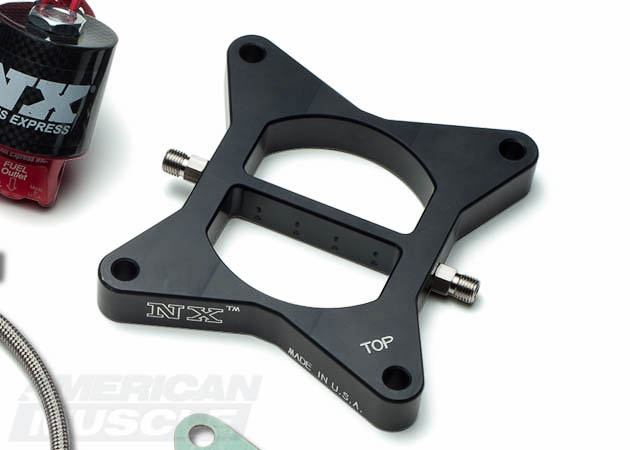
Injector Plate
Differences Between Wet and Dry Nitrous Kits
- Wet kits mix nitrous with the fuel directly
- Wet kits incorrectly installed can result in a nitrous backfire
- Dry kits deliver nitrous oxide and fuel separately into your engine
- Dry kits rely on more components to work perfectly
Wet Nitrous Kits for Your Mustang
The wet kit mixes nitrous with the fuel directly. This mixture is then sprayed into the intake tube near the throttle body. Many Mustang tuners prefer the wet kit since it's easier. Afterall, the computer controls the air/fuel ratio. Usually the tuner simply chooses how much timing to give the engine. Also, with a wet nitrous kit there is no need to upgrade your Mustang’s injectors. Since the nitrous is mixed directly with fuel, there is no need for additional fuel over what is regulated for any one given time. You also don’t run the risk of a failed sensor like the mass airflow sensor.
What are the Drawbacks of Installing a Wet Nitrous Kit?
Of course there are some drawbacks. This system, if not installed properly or if it's poorly tuned, can result in a nitrous backfire. Although very amusing to spectators, this can definitely ruin your day. Because of the nitrous in the fuel line, there is more fuel vapor lingering in the intake. If this vapor ignites, it packs some serious power. Sometimes the entire intake will detach from the car in many, many pieces. Always make sure you select a quality tune for your Mustang before installing your nitrous kit.
Bottle Pressure
Unlike the dry kit, bottle pressure with a wet nitrous kit is much more important. Oftentimes a bottle heater is preferred to keep the pressure constant and at an ideal level. In the event the bottle pressure gets low, the result will be a rich condition. This will cause a loss in horsepower when coming off idle.
Something to consider is it's not a good idea to leave a tank in the car during the summer. While it can be fine for certain temperatures, warmer climates will increase the bottle pressure. This can result in seals, hoses, and clamps bursting from the increase in pressure. Not only does this warrant replacement parts, but the loss of nitrous as well. While there is no official temperature or rating before a bottle will have too much expansion, if it's too hot for a person it's definitely too hot for a bottle.
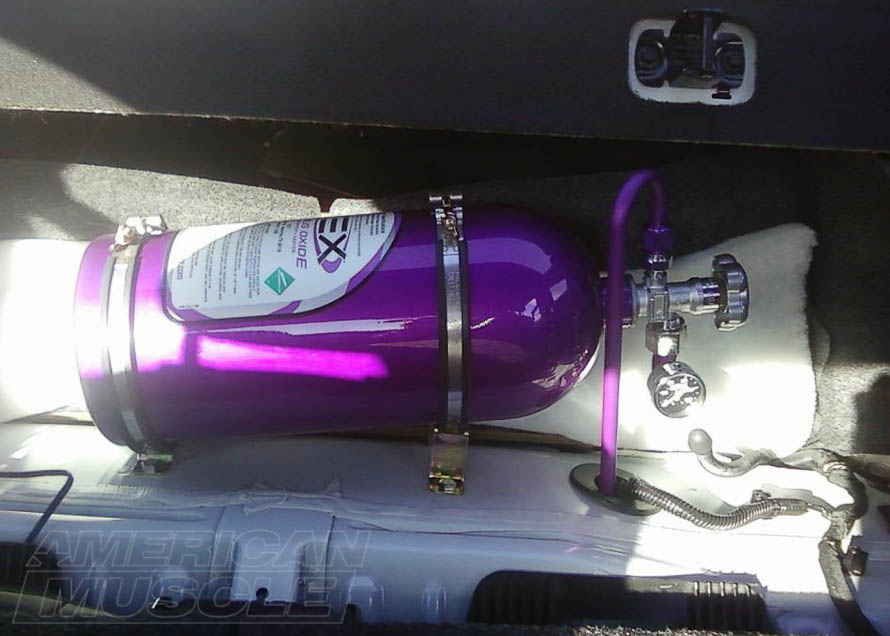
Pressure Gauge Installed on a Nitrous Bottle
Purging the Nitrous Lines
Purging is absolutely necessary. Purging involves venting nitrous into the open air, ensuring the nitrous supply lines are loaded with nitrous and devoid of air. This ensures the mixture will be correct. This is more critical with a wet kit than the dry kit.
Dry Nitrous Kits
A dry nitrous system injects only nitrous into the engine’s intake. Since you’re only controlling the flow of nitrous there’s a single nitrous solenoid, and there’s no solenoid used to control the fuel. This is where “dry” comes from as you are only adding air (nitrous oxide) into the system. However, there is still a need to add fuel to the combustion chamber. This extra fuel is added through the stock fuel system, typically by increasing the fuel pressure.
What the Disadvantages of a Dry Nitrous System?
The dry kit also has its drawbacks. Most tuners are not fond of the dry kit. It requires a bit more skill than the wet kit. This system can be finicky and temperamental. Many times the injectors will need to be switched out to a high flow type. They must be in perfect working order and not driven more than 85% duty cycle. With the dry kit, you are relying on the injectors, MAF, and the computer to add the extra fuel required. If one of these electrical components fails, poof goes the engine.
Other Common Components - Bottle Heater
For proper and consistent operation the bottle pressure must be at an optimum pressure of 900-950 psi. Both a bottle blanket and bottle heater are different ways to achieve this. A bottle blanket helps to trap heat in the bottle when cold and to help shield it from the sun when it’s warm. Its use is more limited than a bottle heater in cold weather. A bottle heater does exactly what you think it would do: heating the bottle up if it’s too cold and the pressure too low.
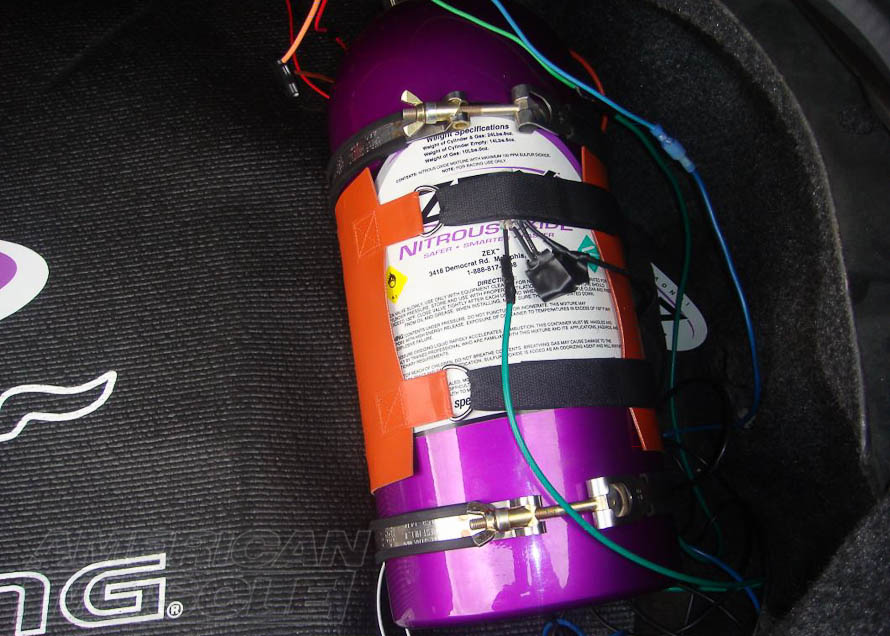
Bottle Wrapped in a Bottle Heater
Pressure Gauge/Regulator
Without a pressure gauge it would be impossible to know whether you need a warmer bottle or not. While typically mounted on the bottle, some installations also use a gauge visible to the driver. In such cases the driver often has a fuel pressure gauge as well, allowing the fuel pressure to be monitored too. A pressure regulator can also be installed to automatically vent the pressure to a desired level in the event it’s too high.
Purge Valve
If you’ve been to the drag strip and seen a car blow out what appears to be steam from around the hood, you’ve probably witnessed a nitrous purge. A purge valve kit is what it takes to do this, and while it can be intimidating to the driver beside you, it serves a couple of functional purposes as well. The first is to rid the system of any air, making sure only a pure nitrous oxide mix is present. Air in the line can cause an engine to run rich and bog for a fraction of a second, hindering performance.
The second function of a purge valve is to reduce bottle pressure. Consistent runs require a precise pressure and having the pressure a little high before you get to the starting line allows you to purge the system and bring the pressure down to where you want it. Relieving pressure is quick and easy, but raising it is not. The track isn’t going to wait on you to heat the bottle up while staging, but the mere seconds a purge requires can easily be performed during this time frame.
Remote Valve
A remote valve allows you to open and close the nitrous bottle with a simple flick of the switch. This is convenient for those times you may want to open the bottle, while never leaving the driver’s seat.
Myths Regarding Nitrous Oxide & Use with Your Mustang
Due to the improper use and misunderstanding of nitrous, there are many myths circling about it. Many of these myths are from misinformed users and give the power adder a bad reputation.
Is nitrous oxide flammable? Many think nitrous is a highly volatile flammable gas. That couldn’t be further from the truth. Nitrous is not flammable at all and used alone it will not ignite. Nitrous only provides more oxygen to be burned and a colder intake charge.
Is medical grade nitrous the same as automotive nitrous? Before you start huffing your nitrous bottle, please realize it's not the same as what the dentist gives you. It is not intended for medical use. Medical grade nitrous is the purest form of nitrous oxide. There is also no performance advantage to using medical nitrous in your Mustang.
Getting the Power Right - Setting Up the Flow
One of the great things about nitrous is you can set it up to fit your driving/racing style, suited specifically to your needs. Nitrous can be setup to only go on once you are at wide-open throttle (WOT), or you could have it gradually increase throughout your RPM range. Of course, there is the classic method of having a button and hitting it exactly when you need it. There are many ways to use a nitrous system. It really comes down to what suites your needs best.
Choose the Best Kit for You & Your Mustang
As with any power adder, it's recommended the engine be designed and built to handle the power. A forged rotating assembly is highly recommended. If properly installed and used, nitrous is no more damaging than a supercharger or turbo. In fact, since nitrous is only used on demand and not constantly, many consider it to be the safest power adder for the cost.
The ease of installation also makes it very appealing. There are numerous companies who sell nitrous kit applications specific to your Mustang. Whether wet or dry, choose the kit that best fits you and your Mustang. Your goals dictate which kit and components will work best for you.
Fitment includes: 1979, 1980, 1981, 1982, 1983, 1984, 1985, 1986, 1987, 1988, 1989, 1990, 1991, 1992, 1993, 1994, 1995, 1996, 1997, 1998, 1999, 2000, 2001, 2002, 2003, 2004, 2005, 2006, 2007, 2008, 2009, 2010, 2011, 2012, 2013, 2014, 2015, 2016, 2017, 2018, 2019, GT, V6, Cobra, ShelbyGT500, Mach1, Bullitt, Boss, LX, SVO, EcoBoost, ShelbyGT350


